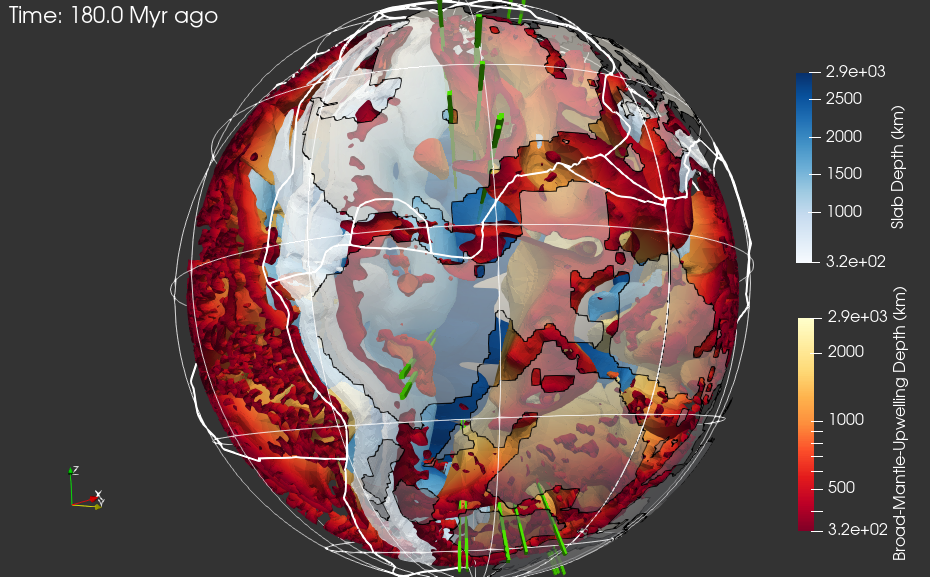 Figure 1. A snapshot of Case1 mantle flow model at 180 Ma at reduced resolution, showing broad mantle upwellings colored by depth (warm colors), subduction zones and sinking slabs colored by depth (cold colors), reconstructed cratons in grey and kimberlites in green columns extending from core-mantle boundary to eruption sites.
Figure 1. A snapshot of Case1 mantle flow model at 180 Ma at reduced resolution, showing broad mantle upwellings colored by depth (warm colors), subduction zones and sinking slabs colored by depth (cold colors), reconstructed cratons in grey and kimberlites in green columns extending from core-mantle boundary to eruption sites.
 Figure 2. Broad mantle upwelling at 180 Ma for Case 1, averaged for depths between 322 km and 2,860 km, overlain by reconstructed cratonic blocks (grey polygons) and kimberlites (green circles).
Figure 2. Broad mantle upwelling at 180 Ma for Case 1, averaged for depths between 322 km and 2,860 km, overlain by reconstructed cratonic blocks (grey polygons) and kimberlites (green circles).
This is a supplement to the paper entitled "Kimberlite magmatism fed by upwelling above mobile basal mantle structures" published in Nature Geoscience.
This supplement aims at providing users to be able access model outputs as well as to reproduce maps and 3-D images of radial heat advection (RHA). All bash scripts are provided in the main directory.
-
"CreateMap.sh" allows users to access #.xyz files which lists lat/lon/RHA for Cases 1-4 (data given in respective folders with Case name as folder name in this directory) at every 20 Myr between 200 Ma and present day (recreating Figure 2a, Extended Data Figures 3-right column, 4,6), and maps the RHA in Robinson projected coordinates, overlain by reconstructed cratons in grey, and reconstructed kimberlites plotted as filled circles with a colormap varying by time. Outputs (PDF files) are also provided in respective folders "Output-Case#" for reference. The script requires users to choose the model to be processsed as well as mantle region (Upper/Lower/Whole Mantle only for Case 1).
CaseNumber=1 # Select the case numberDepending on the choice of model and mantle region, some of the parts of the script will need to be commented (or commented out). This information can be found in the explanation lines or comments within the script. -
"Figure1.sh" allows users to recreate Figure 1a,b. Users need to choose the reconstruction model (M21 or M21 NNR) from the line below:
CaseNumber=4 # 4 for M21 (1 for M21-NNR). The script uses different colormaps for tomographic model and age of reconstructed kimberlies, which are also provided in the main directory. -
"Distance-to-Hot-Map.sh" allows users to create maps of distance to hot structures in tomographic models or distance to RHA field in geodynamic models Cases1-4. User can recreate Extended Data Figure 3a and Extended Data Figure 3 (left column). In its current version, it takes SEMUCB-WM1 tomographic model filtered to maximum spherical harmonic degree 12 (l_max_=12), calculates and maps the angular distance away from the contour dVs=-0.1% towards positive (colder) regions.
-
"Statistical-Analysis" allows users to apply the Kolmogorov-Smirnov statistical test on Mantle flow cases (Cases1-4) and seismic tomographic model cross-sections at depth. It calculates distance to hot structures, compares it with random points spread on constrainted regions (cratons in our case) and applies K-S statistical tests to determine its uniqueness or non-randomness which is presented as success rate(%).
-
"ParaView" folder includes a state file "Case1-Radial-Heat-Advection-Simplified.pvsm" located in the subfolder "State-File" that can uploads broad mantle upwellings, slabs, reconsturcted cratons, plate boundaries and kimberlite eruptions shown as columns and sampled with a buffer of 10 Myr before/after eruption age shown at eveyr 20 Myr since 200 Ma (million years ago).
Please send me email of your questions or requests regarding this repository at omer@uow.edu.au (temporary) or ofbodur@gmail.com (permanent email adrress).